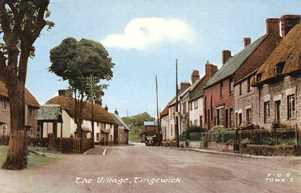Geologist and science writer Nina Morgan recalls a generous offer that went viral
 In 1856 workers cutting brick clay from the glacial deposits overlying the Middle Jurassic Cornbrash limestones on a farm in Tingewick, Buckinghamshire (pictured), owned by a Mr Greaves, hit on a haul of 'concretionary objects' at a depth of about six feet – and kicked off a 'Fossil Rush'. When the fossil material was first discovered, specimens were sent to the surgeon and natural history enthusiast, William Stowe [c.1791 – 1860]. Stowe, in turn, reported his impressions of the find to a local Oxford paper, which noted that:
In 1856 workers cutting brick clay from the glacial deposits overlying the Middle Jurassic Cornbrash limestones on a farm in Tingewick, Buckinghamshire (pictured), owned by a Mr Greaves, hit on a haul of 'concretionary objects' at a depth of about six feet – and kicked off a 'Fossil Rush'. When the fossil material was first discovered, specimens were sent to the surgeon and natural history enthusiast, William Stowe [c.1791 – 1860]. Stowe, in turn, reported his impressions of the find to a local Oxford paper, which noted that:
"... We are authorised to say that Mr Stowe would send specimens to any institution or individual who takes an interest in such matters on their paying the carriage by rail."
News goes viral
The Oxford report, including Stowe's generous offer, was picked up by The Times on 6 January 1857 and such was the interest that Stowe quickly found himself embroiled in a 19th Century version of a Twitterstorm. In an attempt to calm matters, Stowe himself wrote to The Times on 9 January saying:
"Sir – The transference of a paragraph about fossils from a local paper into your word-wide publication has overwhelmed me with applications for them, having had about 70 in 24 hours, which it is impossible to attend to at once. I propose sending them off as widely as I can, and, in the meantime allow me to say that there are specimens to be seen in the Geological Museum in Jermyn-street, whither I sent them a week ago. Yours truly, W. Stowe, Buckingham, Jan 8."
The following day The Times published a letter written under the pseudonym Conchos, highlighting another source for obtaining similar fossils:
"Sir – Perhaps the fossil collectors who have overwhelmed your Buckingham correspondent, W. Stowe, whose letter appears in your columns of to-day, may feel interested in the fact that, in excavating for the sewers on the new London road now forming to shorten the distance from central Essex and the Lea-bridge-road to the metropolis, the workmen have within the last few days, at a depth of about 20 feet, dug into a bed of sea sand, containing numerous shells, both univalves and bivalves of supposed extinct species, commingled with what appears to be drift wood in large pieces, now quite black, thus evidencing that at some period of our world's history the seashore reached to Upper Clapton. For those curious in the matter I may add that the site of this discovery is not far from where Clapton-gate formerly stood – for that barbarian barrier, with its ante-diluvian gatehouse is, if not fossilised, at least disintegrated, and now, like the inhabitants of the said uni and bi valves, among the "things that were, but are not" – and on the new line of the road thus thrown open opposite its site, proceeding west and south-west towards London. The distance is about two and a-half or three miles from the Royal Exchange. I am, Sir, your obedient servant. CONCHOS, London Jan. 9."
But in spite of Conchos's suggestion, requests for specimens continued to pour into Mr Stowe's letterbox. An article about the Tingewick fossil find in The Illustrated London News of 24 January 1857 reported that:
"We understand that Mr Stowe has been almost overwhelmed with some 170 letters applying for specimens; but he is unable to go on satisfying the claimants, as the men have ceased to dig clay for the season."
Whetting appetites
The Illustrated London News piece probably did nothing to stem the tide of specimen requests. Their writer noted that many of the fossils:
"... are like biscuits, others like Lilliputian mince-pies and oysters. Others are like roots of ginger and compressed mushrooms of all sizes – the smaller or button-shaped ones simulating mince-pies, and the larger ones so like biscuits that at an evening party they were put on the supper-table and taken for real biscuits."
With a description like that, the temptation for many a society hostess to claim samples of the fossils to grace their buffet table must have been great – the risk of broken teeth notwithstanding!
Acknowledgements
Sources for this vignette include: Geological Collecting and a Geological Career: Daniel Jones (1836 – 1918) with notes on other Midlands Collections from the Jones Archive by Hugh Torrens, Geological Curator, Vol. 4, pp. 493 – 501; Letters to the Times from W. Stowe, and Conchus published on 8 and 9 January 1857, respectively; and Fossils Found in Buckinghamshire, published in The Illustrated London News, 24 January 1857, pp. 67 – 68.
* Nina Morgan is a geologist and science writer based near Oxford. Her latest book, The Geology of Oxford Gravestones, is available via Gravestone Geology